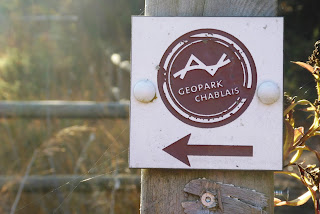The Pierre à Martin
We'd searched unsuccessfully before for this erratic and even this time, with the benefit of checking online first, we overshot before ending up in the right place. Great signposts from Ballaison up the hill, but then the final, critical one isn't there - I guess they think "well, it's an enormous rock, in the middle of the field, how can anybody miss it?!"
 |
| Spotted it yet? |
 |
| The avenue |
 |
| Distant view of the Salève, on the far side of Annemasse |
From our position on the Mont de Boisy it was clear that there was a temperature inversion type mist hanging over the lake and surrounding lowlands.
 |
| The erratics and their routes |
The glacier was extensive and around 27 ka ago it filled the entire Lac Leman basin before retreating and leaving behind mounds of glacial sand and clay, along with pebbles, cobbles and large blocks.
 |
| The Rhône glacier during the Planbois stadial (27 - 25 ka) a pause during its retreat. Present Lac Leman is the black dotted line. |
Similarly, at the end of the Planbois stadial, the lake of Planbois formed: clay deposited in the lake was used for tile making right through from Roman times until the 1970s (which is why there are various places marked as Tuileries on the local map).
On the information boards, besides the history of scientific explanation of erratics, we found the legend of St Martin, the Devil and the Catapult:
"A story claimed that Satan and St. Martin met together for a contest. One day when Martin meditated at the top of the Voirons, the Devil put a challenge to him: which of the two would manage to throw a huge rock all the way to the lake, passing over the bell tower of Nernier?
"Martin accepted the dare, planted his cane in a block, twirled it over his head and hurled it successfully. The Devil, vexed, wanted to do the same, He uprooted two huge fir trees and made a sling. He hoped to crush Nernier's presbytery with this improvised catapult, because the priest of the village had converted too many souls.
"But Martin understood the trick. He made a sign of the cross, just when his terrible adversary was going to execute his deadly throw. Satan, distracted and troubled, missed his shot. The stone spun and fell into a field on Mont de Boisy. It has been there ever since."
Geology and viticulture
The vines in the local Crepy vineyards grow on glacial soil, usually impermeable, but this soil has had the finer material washed out of it, leaving coarser, well drained, sand and gravel ideal for vines.We had a good view of the Pierre a Martin from the hill
 |
| Pierre a Martin from the SW |
 |
| There was a glacial lake - Lac Planbois - in the low ground between us and the hills. Now woodland as it has long since become choked with vegetation. |
 |
| Granite |
 |
| Gneiss/schist |
 |
| The gneiss in the Pierre a Martin has been folded post metamorphism |
 |
| Gneissic texture here seen under an overhang - the platy minerals are greenish - some chlorite? |
 |
| And finally, this has some titchy little garnets in it! |
Postscript
A couple of days later we went for a walk at the Domaine de la Rovoree on the lakeside and there, in the castle ruins, found a couple more erratics - one gneiss and one granite - though well covered with biology!
That's all for now!









